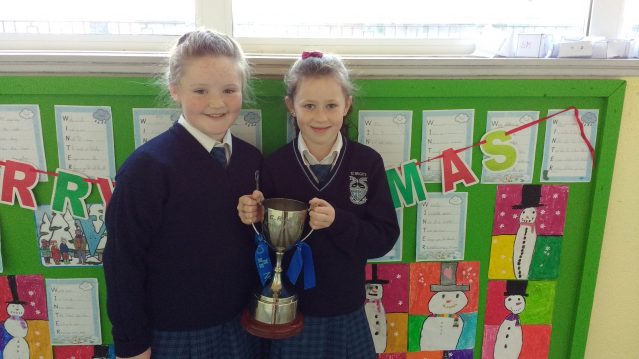
Dublin Under 9’s Irish Dancing Champion


In sixth class, we made Saint Brigid’s crosses. They are made from rushes. Ms. Mc Carry got the rushes in Donegal. The cross usually has a square shape in the centre followed for groups of rushes that form a cross. Some people say Saint Brigid’s cross is related to the sun cross. The crosses are traditionally made on the feast day of Saint Brigid, the first of February. The woven rushes are thought to keep evil, fire and hunger from the homes in which it is displayed.
Saint Brigid was born in Faughart in County Louth. She lived in a farmhouse. She always helped out by doing many jobs around the farm like herding cattle and churning butter.
When she was growing up Brigid was a kind and loving child. She loved learning and always seized the opportunity to learn something new.
Most of all she loved to help people. She especially liked to help those most in need like beggars, the sick or the lonely. She gave these people food and cared for them. These people often felt better when in the care of Saint Brigid. Brigid would never leave someone in need and always put others needs before her own.
Brigid grew up to be a wonderful and kind woman and many noble lords wanted to marry her. Brigid had no desire to be married and instead she became a nun. Her father Dubtach was angry at this but Brigid forgave him and knew that he just didn’t understand.
Brigid is the Patron Saint of Ireland. She is loved and admired by many.
Some interesting points on WWI
How Did It Start? World War 1 started when the an assassin assassinated Franz Ferdinand, the heir to the throne in Austria-Hungary.
What Did World War One Do For Women? Back then, men thought that if they gave women jobs that the women would put men out of work. So World war One did create jobs for some women as eventually there weren’t many men left to do the jobs because they were all already working.
Hobbies Back Then…
Back then women’s football became a lot more popular. There were even some teams for women to play on.
Our Science experiment
On the 29th of January 2016, we did science experiments on floating and sinking.
First we did an experiment to see if an orange would sink or float and then would it float or sink without the peeling. We had to predict if it would sink or float. It floated with the peeling on and sank with the peeling off.
Next we got into groups and we picked out objects that we wanted to put in the bucket of water to see if the objects were heavier in air or water.
First, we weighed a banana in air using a spring balance. It weighed one hundred and fifty grams. We weighed the banana in water and it weighed fifty grams. The banana weighed more in air.
Next we weighed a bottle of juice. It weighed two hundred grams in air and one hundred grams in water.
Last of all we weighed an orange. In air it weighed eighty grams and in water it weighed zero grams.
So objects weigh more in air because the force of gravity pushes the object up in water.
was created along with our crest in 2012 and both continue to be as relevant today as they were then.
